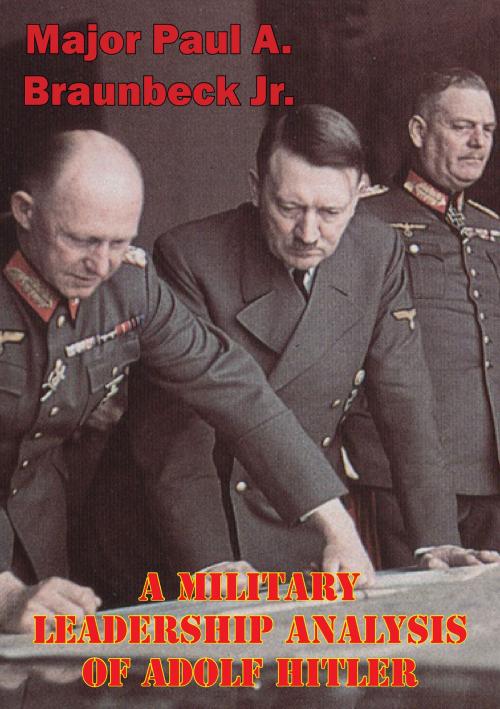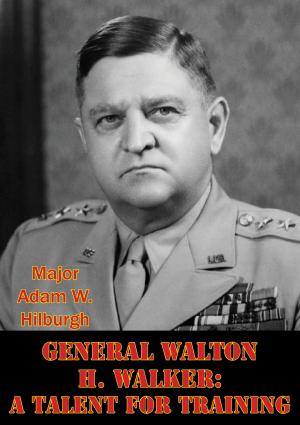A Military Leadership Analysis Of Adolf Hitler
Nonfiction, History, Germany, European General, Military, United States| Author: | Major Paul A. Braunbeck Jr. | ISBN: | 9781782897101 |
| Publisher: | Lucknow Books | Publication: | August 15, 2014 |
| Imprint: | Lucknow Books | Language: | English |
| Author: | Major Paul A. Braunbeck Jr. |
| ISBN: | 9781782897101 |
| Publisher: | Lucknow Books |
| Publication: | August 15, 2014 |
| Imprint: | Lucknow Books |
| Language: | English |
“Before the war, and still more during the conquest of the West, Hitler came to appear a gigantic figure, combining the strategy of a Napoleon with the cunning of a Machiavelli and the fanatical fervour of a Mohomet. After his first check in Russia, his figure began to shrink, and towards the end he was regarded as a blundering amateur in the military field, whose crazy orders and crass ignorance had been the Allies’ greatest asset. All the disasters of the German Army were attributed to Hitler; all its successes were credited to the German General Staff.” - B. H. Liddell Hart
Liddell Hart goes on to say that while this description of Adolf Hitler may not be entirely true, there is certainly some truth to it. While conducting the research for this project, it became increasing apparent that in the late 1930s Hitler was indeed a successful military leader. The impetus behind this success was partly due to Hitler’s political decision making process which, in effect, laid the foundation for World War II. However, as his success continued to mount, he became more and more involved in the intricacies of battlefield tactics and strategy. This is where Hitler’s and Germany’s eventual downfall for the conquest of Europe began. Upon examining Hitler’s strengths, weaknesses, and decision making processes as a military leader one can begin to fully appreciate how the infamous “stop” order at Dunkirk and his “no retreat” policy at Stalingrad are often referred to as Hitler’s greatest blunders of World War II.
“Before the war, and still more during the conquest of the West, Hitler came to appear a gigantic figure, combining the strategy of a Napoleon with the cunning of a Machiavelli and the fanatical fervour of a Mohomet. After his first check in Russia, his figure began to shrink, and towards the end he was regarded as a blundering amateur in the military field, whose crazy orders and crass ignorance had been the Allies’ greatest asset. All the disasters of the German Army were attributed to Hitler; all its successes were credited to the German General Staff.” - B. H. Liddell Hart
Liddell Hart goes on to say that while this description of Adolf Hitler may not be entirely true, there is certainly some truth to it. While conducting the research for this project, it became increasing apparent that in the late 1930s Hitler was indeed a successful military leader. The impetus behind this success was partly due to Hitler’s political decision making process which, in effect, laid the foundation for World War II. However, as his success continued to mount, he became more and more involved in the intricacies of battlefield tactics and strategy. This is where Hitler’s and Germany’s eventual downfall for the conquest of Europe began. Upon examining Hitler’s strengths, weaknesses, and decision making processes as a military leader one can begin to fully appreciate how the infamous “stop” order at Dunkirk and his “no retreat” policy at Stalingrad are often referred to as Hitler’s greatest blunders of World War II.

![Cover of the book The Dynamics Of Doctrine: The Changes In German Tactical Doctrine During The First World War [Illustrated Edition] by Major Paul A. Braunbeck Jr.](https://www.kuoky.com/images/2015/november/300x300/9781786250193-hbLT_300x.jpg)



![Cover of the book G. H. Q. (Montreuil-Sur-Mer) [Illustrated Edition] by Major Paul A. Braunbeck Jr.](https://www.kuoky.com/images/2015/november/300x300/9781786255303-NxM3_300x.jpg)








![Cover of the book A Surgeon In Khaki [Illustrated Edition] by Major Paul A. Braunbeck Jr.](https://www.kuoky.com/images/2014/august/300x300/9781782892700-YwlT_300x.jpg)
